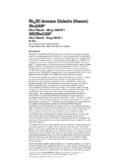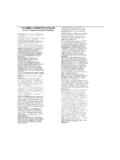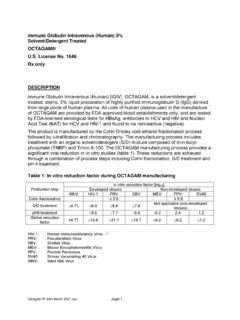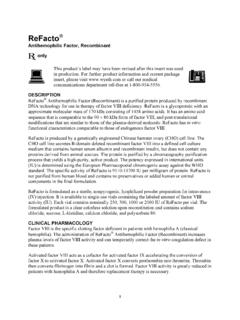Transcription of Rh (D) Immune Globulin (Human) - abopharmaceuticals.com
1 Rho(D) Immune Globulin ( human ). RhoGAM . Ultra-Filtered 300 g (1500 IU*). MICRhoGAM . Ultra-Filtered 50 g (250 IU*). Rx Only For Intramuscular Injection Only Preservative-free, latex-free delivery system DESCRIPTION. RhoGAM and MICRhoGAM Rho(D) Immune Globulin ( human ) are sterile solutions containing IgG anti-D (anti-Rh) for use in preventing Rh immunization. They are manufactured from human plasma containing anti-D. A single dose of RhoGAM contains sufficient anti-D (approximately 300 g or 1500 IU)* to suppress the Immune response to 15 mL (or less) of Rh-positive red blood ,3 A single dose of MICRhoGAM contains sufficient anti-D (approximately 50 g or 250 IU)* to suppress the Immune response to mL (or less) of Rh-positive red blood cells.
2 The anti-D dose is measured by comparison to the RhoGAM in-house reference standard, the potency of which is established relative to the US/WHO/EP Standard Anti-D Immunoglobulin Rho(D) Immune Globulin ( human ) CBER Lot 4: NIBSC Lot 01/572 (285 IU/ampoule). All donors are carefully screened by history and laboratory testing to reduce the risk of transmitting blood-borne pathogens from infected donors. Fractionation of the plasma is performed by a modification of the cold alcohol procedure that has been shown to significantly lower viral Following fractionation, an additional viral-clearance filtration step is incorporated into the manufacturing process. This filtration step removes viruses via a size-exclusion mechanism utilizing a patented Viresolve 180.
3 Ultrafiltration membrane with defined pore-size distribution of 12-18. nanometers. The ultrafiltration step utilizes tangential flow filtration to permit filtration of IgG while effectively retarding enveloped and non- enveloped viruses above the pore-size distribution cutoff. The filter is inert to the product. Non-enveloped viruses are known to be resistant to chemical and physical ,6 Laboratory spiking studies have shown that the cumulative viral removal capability of the RhoGAM/MICRhoGAM. manufacturing process exceeds 13 logs for human immunodeficiency virus (HIV). Clearance of model viruses for hepatitis C virus (HCV), hepatitis B virus (HBV) and parvovirus B19 (a non-enveloped virus) exceeds 11 The donor selection process, the fractionation process and the Viresolve ultrafiltration step are designed to increase product safety by reducing the risk of transmission of enveloped and non-enveloped viruses.
4 Rho(D). Immune Globulin ( human ) intended for intramuscular use and prepared by cold alcohol fractionation has not been reported to transmit hepatitis or other infectious The safety of Rho(D) Immune Globulin ( human ) has been further shown in an empirical study of viral marker rates in female blood donors in the United This study revealed that Rh-negative donors, of whom an estimated 55-60% had received Rho(D) Immune Globulin ( human ) for pregnancy-related indications, had prevalence and incidence viral marker rates similar to those of Rh-positive female donors who had not received Rho(D) Immune Globulin ( human ). However, even after the fractionation and virus-filtration steps, there remains a risk of contracting blood-borne pathogens from a plasma- derived product.
5 The final product contains approximately 5 1% gamma Globulin , mg/mL. sodium chloride, polysorbate 80 and 15 mg/mL glycine. Small amounts of IgA, typically less than 15 g per dose, are The pH range is The product contains no preservative and utilizes a latex-free delivery system. *The anti-D content of RhoGAM/MICRhoGAM is expressed as g per dose or as International Units (IU) per dose. The conversion factor is 1 g = 5 Viresolve is a trademark of Millipore Corporation. CLINICAL PHARMACOLOGY. Mechanism of Action RhoGAM and MICRhoGAM act by suppressing the Immune response of Rh-negative individuals to Rh-positive red blood cells. The mechanism of action is unknown. RhoGAM, MICRhoGAM and other Rho(D) Immune Globulin ( human ) products are not effective in altering the course or consequences of Rh immunization once it has occurred.
6 Obstetrical Use The Rh-negative obstetrical patient may be exposed to red blood cells from her Rh-positive fetus during the normal course of pregnancy or after obstetrical procedures or abdominal trauma. Clinical studies have proven that the incidence of Rh immunization as a result of pregnancy was reduced to 1-2% from 12-13% when RhoGAM was given within 72 hours following ,11 Antepartum administration of Rh Immune Globulin at 28 weeks, as well as within 72 hours of delivery, has been shown to reduce the Rh immunization rate to about ,13. Clinical studies demonstrated that administration of MICRhoGAM within three hours following abortion was 100% effective in preventing Rh Use after Rh Incompatible Transfusion An Rh-negative individual transfused with one unit of Rh-positive red blood cells has about an 80% likelihood of producing However, Rh immunization can occur after exposure to < 1 mL of Rh-positive red blood cells.
7 Protection from Rh immunization is accomplished by administering the appropriate dose of RhoGAM or MICRhoGAM, which is > 20 g per mL. of Rh-positive red blood cells, within 72 hours of transfusion of incompatible red ,15 (See DOSAGE AND ADMINISTRATION section.). Pharmacokinetic Properties Pharmacokinetic studies after intramuscular injection were performed on eight Rh-negative Six subjects received a single dose (300 g). of RhoGAM, while two subjects received four doses (1200 g). Plasma anti-D levels were monitored for four months using a validated method with sensitivity of approximately 1 ng/mL. The parameters measured and/or calculated included the following: Cmax = maximum plasma concentration obtained (ng/mL).
8 Tmax = time to attain Cmax (days). T1/2 = elimination half-life (days). Vd = volume of distribution (liters). Mean Pharmacokinetic Parameters for RhoGAM. Parameter Single Dose Four Doses Dose Ratio (n = 6) (n = 2) (1/4). Cmax Tmax 5 5 T1/2 Vd INDICATIONS AND USAGE. Pregnancy and Other Obstetrical Conditions in Rh-Negative Women, Unless the Father or Baby are Conclusively Rh Negative Pregnancy/delivery of an Rh-positive baby irrespective of the ABO groups of the mother and baby Abortion/threatened abortion at any stage of gestation Ectopic pregnancy Antepartum fetal-maternal hemorrhage (suspected or proven) resulting from antepartum hemorrhage ( , placenta previa), amniocentesis, chorionic villus sampling, percutaneous umbilical blood sampling, other obstetrical manipulative procedure ( , version)
9 Or abdominal trauma Transfusion of Rh incompatible blood or blood products Transfusion Prevention of Rh immunization in any Rh-negative person after incompatible transfusion of Rh-positive blood or blood products ( , red blood cells, platelet concentrates, granulocyte concentrates). CONTRAINDICATIONS. Individuals known to have had an anaphylactic or severe systemic reaction to human Globulin should not receive RhoGAM, MICRhoGAM or any other Rho(D) Immune Globulin ( human ). WARNINGS. RhoGAM and MICRhoGAM are made from human plasma. Because these products are made from human blood, they may carry a risk of transmitting infectious agents, , viruses, and, theoretically, the Creutzfeldt-Jakob disease (CJD) agent.
10 The risk that such products will transmit an infectious agent has been reduced by screening plasma donors for prior exposure to certain viruses, by testing for the presence of certain current virus infections and by removing certain viruses during the manufacturing process. Following fractionation, an additional viral-clearance filtration step is incorporated into the manufacturing process. This filtration step removes viruses via a size-exclusion mechanism utilizing a patented Viresolve 180 ultrafiltration membrane with a defined pore-size distribution of 12-18 nanometers. The filter is inert to the product. This virus removal process has been shown in laboratory spiking studies to reduce the levels of some viruses ranging from 18-200 nanometers in size, including enveloped viruses as well as non-enveloped All of the above steps are designed to increase product safety by reducing the risk of transmission of lipid-enveloped and non-lipid-enveloped viruses.











